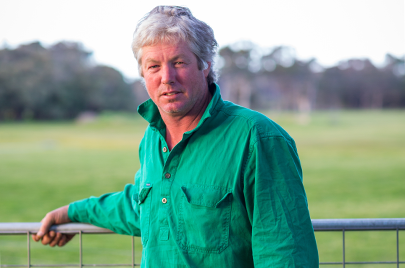Getting better at grazing
| On-Farm Snapshot | |
|---|---|
| Name/s | Matt Nield and Emma Pinnick |
| Location | Karridale, WA |
| Property | 530ha leased |
| Soils | Sandy, gravel and karri loam. |
| Enterprise | Wool and prime lambs. 6,500 Merino ewes and wethers (2,000 joined to Merino sires; 2,000 joined to Poll Dorset sires) |
WA PGS State Co-ordinator Rebecca Wallis said the collaborative nature of PGS learning was one of the highest valued aspects among participants.
She said the PGS approach to adoption was based on the premise that increasing the profitability of grazing businesses requires improvement in skill and management capability.
“To embed skills requires not only knowing what to do but how to do it. The best way to do this is a supported learning model where there is opportunity to learn, practice and apply new skills over time with other producers, supported by a coach who is an expert in that particular field,” she said.
Rebecca said the benefits from a PGS program are long term, extending far beyond one season.

Improved lamb compliance and better feedbase production are two of the clear outcomes WA's Matt Nield and Emma Pinnick have found from MLA's Profitable Grazing Systems (PGS) training.
The couple, who their self-replacing flock at “Blackwood Grazing”, near Augusta, have already completed the Grazing Matcher™ program through PGS, and are part way through Benchmarking for Profit. PGS is MLA's adoption and extension platform offering training packages delivered according to local industry needs.
Matt believes if producers are not always learning, they are not going forward. Now, he also believes one of the best ways to learn is to take advantage of the experience and knowledge of others.
Matt and Emma have taken a strategic approach since setting up the business from scratch five years ago. It is run on 100% leased country and their business plan focuses on building resilience and continually improving performance.
The decision was recently made to carry Merino wethers through to two-and-a-half years of age to increase stocking rates, and therefore productivity, and to build in a buffer for tough seasons in the way of having dry sheep to offload first.
Learning from dairy
The desire for resilience led to them participating in Grazing Matcher™, a 12-month program delivered via a supported coaching model with one-on-one and group learning. Grazing Matcher is an initiative of animal production advisor Jeisane Accioly, who has partnered with former dairy researcher Martin Staines and agronomist Dan Parnell, to help producers improve grazing management and business performance.
“The way the training was structured as group and one-on-one learning - including going to each other's farm and discussing what you see and what has worked for others – was also a big benefit because that allowed me to get the most value for the investment and time I was putting in," Matt said.
“When you spend money to go and do something like this, you want to get the best return so you listen and react.”
Matt said the collaborative nature of the training was exceptionally valuable.
“Presenters in the group are heavily involved in milk production. Dairy farmers are the best at growing grass and grass utilisation,” he said.
“I’ve known about much of what this training covered because dairy is in our area but I’ve never sat down and been shown just what can be achieved.
Getting better at grass management
Grazing Matcher supports producers to match grazing inputs with outputs and through skills based learning empowers producers to set a grazing strategy using feed budgeting established through monitoring and managing pastures and animal condition. Producers also learn skills with farm mapping, seeding and fertiliser application, making seasonal adjustments, understanding cost of producer and improving market compliance.
“What we came away with was that it’s all about the management of the grass – not changing what we grow (ryegrass and clover) but strategic rotational grazing,” Matt said.
“Before we were hit and miss – we’d shift sheep in a haphazard fashion with no science behind those decisions.
“Now we look at plant growth, rather than food on offer, to make decisions. Plant growth is measured through leaf stage – we graze at three leaf, then let it return back to that stage before grazing again.”
Matt said after implementing strategic grazing, the wool cut was up, lamb were two kilograms higher at weaning and there was more grass later in the season.
“All this was achieved in a year where we were feeding at lambing, which is usually unheard of. Last year’s break came seven weeks post average,” he said.
“While we consider that a very good result, we take the view this is not something you do in just one year, but rather is gradually implemented over time as there is capital expenditure involved. So the benefits will be ongoing.”
The bottom line
“We're looking to find out what we are doing well, what we can do better and basically where the holes in our system might be,” Matt said.
“It's not so much about comparing ourselves with others but finding where we have scope to improve, based on years of information collected.
“We don’t want to be chasing the one per cents. We want to be putting effort, time and money into what will actually make more money.”


